Time to Stretch My Arms Again
Do you lot feel tired and stiff after performing? Pilates instructor John Black explains how some simple stretching exercises can make all the difference
Musicians have the general trouble of having to stay in one – often far from natural – position for long periods. In improver there is a lot of rotation involved, with boggling demands made on some small muscle-groups. This can easily exist a recipe for the ills that befall torso tissues held for besides long in i position: neural compression, reduced claret flow, joint stiffness and collagen pitter-patter. Tissues are chemical structures that obey the rules of chemistry and biomechanics, so elastic (or other) fibres, if stretched as well far or for too long, tin can potentially deform permanently.
It is important to be in skilful posture whenever possible, so that the different parts of the torso are correctly aligned, thus placing minimum stress on torso tissues. All the same, the reality for a musician is that less-than-platonic posture is inevitable. The consequences include the overworking of some tissues and underworking of others, leading to imbalances in flexibility and strength; and the misalignment of joints, which then undergo more than habiliment and tear than they would otherwise.
Damage to musculus fibres and connective tissue – which occurs especially during eccentric muscle contractions, when muscles are both lengthening and contracting at the same time – tin can result in muscle tears and the formation of scar tissue, which tends to shorten muscle fibres. So stretching at the appropriate fourth dimension in the healing process is necessary to counter this.
The commencement priority, especially after a long functioning, is to restore correct postural alignment as quickly as possible. This is the purpose of the 'warm-down' exercises hither, which should not have more than a few minutes to do and tin can be done without invading anyone else's space, often while seated. One small caveat: if in attempting to right stiffness you lot experience whatever neural 'zinging', seek professional person advice.

1. STAND Alpine
Stand with feet hip-width apart, draw your lower stomach in and up (a little) and lengthen upwards through the crown of your head, looking straight ahead. Let your artillery hang by your sides, palms facing into thighs. Relax your shoulders and draw shoulder blades gently down your back, but without sticking out your lower ribcage. Then take a few deep breaths, animate IN to the sides and dorsum of your ribcage and OUT cartoon your abs in slightly more.
2. Big SHOULDER-CIRCLES
Bring your shoulders upward to your ears, letting the arms but hang. Then endeavor and touch shoulder blades behind, equally yous circumvolve your shoulders. This is purely to loosen upward your shoulders. Contrary the circles.

3. Impaired WAITER
Take your forearms parallel to the floor and each other, with palms facing up and elbows into your sides. Equally you breathe OUT (drawing your tummy in a trivial), rotate your arms out, keeping your elbows into your sides as much every bit possible. Exhale IN to return them to parallel.

four. OPENINGS
Have upper arms in line with shoulders and have a correct angle at your elbows, palms facing front. Breathing OUT bring right-angled arms tightly together (elbows equally well). Exhale IN every bit you have them wide and stretch dorsum.
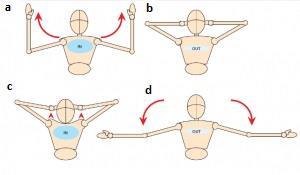
5. FLOATING ARMS
[a] On an IN-breath, float your arms upwards (hands but forward of shoulders), keeping your shoulder blades fatigued down.
[b] Breathe OUT, bringing your forearms backside your head.
[c] On an IN-jiff, shrug your shoulders as loftier equally possible.
[d] On an OUT-breath, lower shoulder blades as far as possible and float the arms back down, keeping shoulder blades cartoon down.
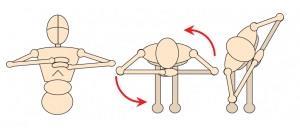
6. THE COSSACK
Place one forearm lightly on the other, keeping shoulders relaxed and open, with shoulder blades drawing downwardly your back, and breathe IN. Animate OUT, rotate arms and head as i unit of measurement to your right, keeping your pelvis facing forward. Exhale IN to return to the front and OUT to turn to the left. Keep alternating. This exercise is easier to exercise sitting (every bit illustrated), because your pelvis is fixed.
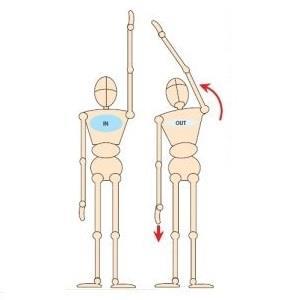
seven. SIDE REACHES
Stand with anxiety parallel and hip-width apart. Breathe IN to lengthen up through the spine, raising i arm every bit you endeavour to go on that shoulder blade cartoon downwardly: animate OUT lengthen as y'all attain up towards the opposite corner of the room, the other hand going downwardly your thigh. Make certain you only become over to the side. Breathe IN to lengthen up again. Alternate side to side.
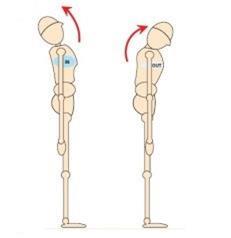
8. FLEX AND EXTEND
Breathe IN and lengthen back and up through the crown of your head, extending your spine back a fiddling while drawing in your tummy. Exhale OUT as you nod your head (chin to chest) and roll your neck forward.
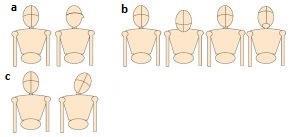
9. NECK TURNS
[a] Continuing tall (eyes direct ahead), keeping mentum parallel with the floor, gently turn your head from side to side to look over each shoulder.
[b] Be tall and expect directly alee, drop chin to chest, then take the caput straight back to look over your head, before coming back to expect horizontal once more.
[c] A side cervix bend. Continue your head to the front end throughout, and take your ear over to your shoulder each side. (Any neural 'zing' – end!)
10. ARM AND FINGER STRETCHES
Agree your right arm out straight in front of yous, palm downwards and elbow locked. With your other hand, gently draw back your fingers. Go on your arm the same, simply this fourth dimension bend the wrist over, drawing the hand back towards you lot with the other hand. Repeat on the other side. Hold your hands out in front end of you, elbows soft, take first and second fingers together abroad from the 4th and fifth, also together, creating a gap. Return, and alternate with separating showtime and 4th fingers from the eye two, which stay together
11. Whorl DOWNS
If you have no serious issues with your back, whorl downs (standing with the knees slightly bent, dropping the chin to the chest and letting the rest of the spine gradually curl down towards the floor) are a great exercise to include somewhere in your routine. Do them either with your back against the wall (easier on the dorsum) or gratis standing.
This commodity was first published in The Strad'due south December 2005 issue
Source: https://www.thestrad.com/playing-hub/11-stretching-exercises-for-musicians/27.article
0 Response to "Time to Stretch My Arms Again"
Post a Comment